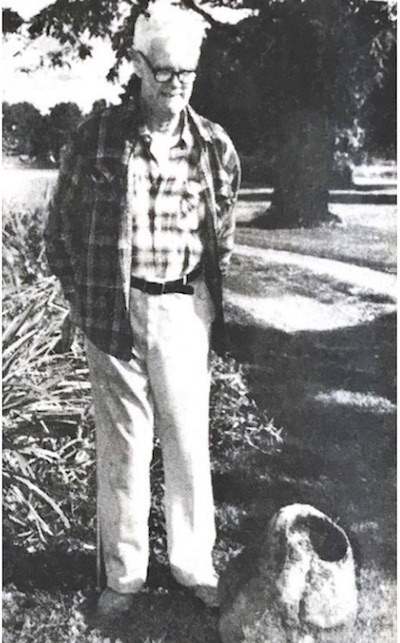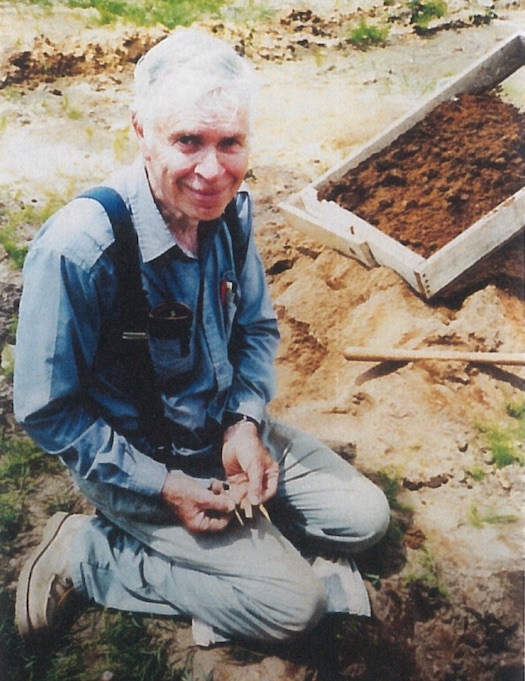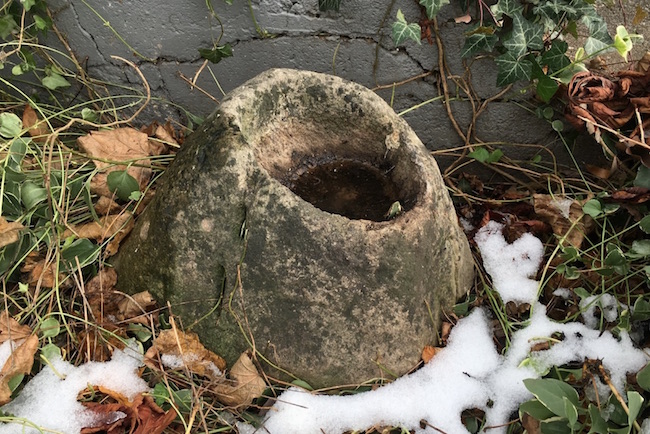Historic Childs: Native American tool – the Cobblestone Museum’s oldest artifact
By Doug Farley & Bill Lattin – Vol. 2 No. 47

Pictured here is Mr. George Morton Pettit of Maple Ridge Road, Medina, standing next to an ancient mortar.
GAINES – It’s not known for certain, but one can make an educated assumption that the Cobblestone Museum’s oldest artifact might be its “mortar.”
This “mortar” is not the typical lime mortar we discuss when we look at the “glue” that holds cobblestone buildings together. This 800-year-old “other” mortar is a Native American tool that the museum acquired in 1993.
The story of this Indian relic was first reported by former director Bill Lattin in an article that he penned in 1993 while serving as Orleans County Historian entitled, “Mort’s Mortar.”
Webster’s Dictionary describes a mortar as “a strong vessel in which material is pounded or rubbed with a pestle.
In 1993, Mr. George Morton Pettit gave this artifact to the Cobblestone Museum at Childs, N.Y. He also related this known history about how it had been passed down in his family.
The Pettits, that is, Henry who was George’s great-grandfather, bought their farm in the Town of Shelby in 1850. George M. Pettit was the fourth generation to grow upon this farm, preceded by his father Clark Pettit and his grandfather also named Clark Pettit.
It seems that Henry Pettit discovered the mortar near a spring in the woods on his farm over a century ago. Being intrigued with this unusual hollowed-out stone, he placed it near the well pump and watering trough in the dooryard.
Mr. Pettit remembers vividly his dog “Shep” of many years ago using this millennial artifact as a water dish! He also recalls when wheat harvest came and they shocked up the bundles they would sometimes find arrowheads on the ground in the general vicinity of where the mortar had been discovered years before. It seems likely that some Native Americans had an encampment in this area several centuries ago.
In due time, Mr. Stanley Vanderlaan (shown above), local archaeologist and an authority on local Indian artifacts and lore, examined the mortar. He indicated that he had never seen one quite like this and indeed, if it was a mortar, thought it rather crude.
However, he felt it possible that it could be as much as 800 years old and probably represents an agrarian culture. Mortars and pestles were used by Indians to grind corn and other grains that they raised.
This mortar, shown above in current setting, appears to be made of limestone and obviously displays some tooling marks around the upper portion. It also sits flat upon the ground and would appear, because of its heavy weight, something which was intended to be more stationary, rather than moveable.
Another interesting connection between this 800-plus year old Indian mortar and the Cobblestone Museum is Mr. Vanderlaan’s assumption that the original pestle for this mortar would most likely have been, none other than, a “cobblestone,” which even then, were abundant in the fields occupied by the Native Peoples.
It goes without saying, that the stone pestle which was originally used is long gone, but the mortar remains as silent testimony to the ancient inhabitants of this area.









































































